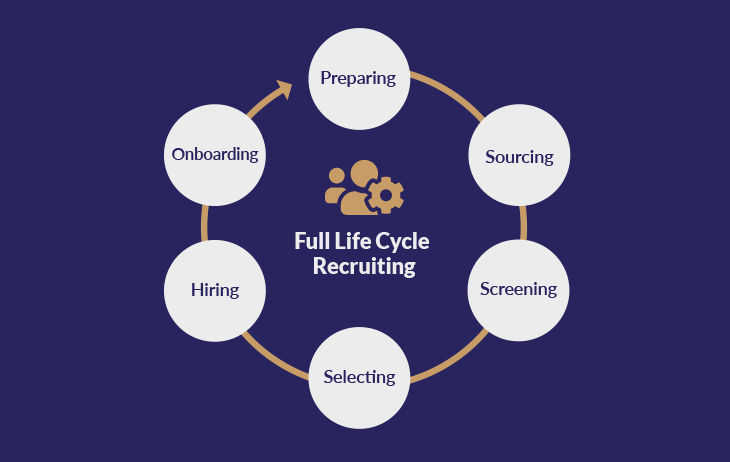Topics: 360 Recruitment, Full Cycle Recruitment, Recruitment Outsourcing
360 Recruitment | Six Stages of Full Life Cycle Recruiting
Posted on May 11, 2022
Written By
Aanchal Jain

Full life cycle recruiting, also known as full circle recruiting or 360 recruitment, refers to the complete recruitment process. Full cycle recruiting is divided into six main stages, which involve end-to-end recruitment solutions to complete a recruiting process from start to finish. It begins from the initial stage of preparation when the need for a new employee rises in an organisation and ends with the new hire’s onboarding.
Usually, a full cycle recruiter is responsible for completing all stages of a recruitment life cycle. Large organisations may have separate teams, HR professionals, or departments to take care of different stages of a full cycle recruitment process. Outsourcing full cycle recruiting or its specific stages such as candidate sourcing, screening, onboarding, etc., is a common practice for staffing firms having huge volumes of hiring requirements.
Take a closer look at the different stages of full life cycle recruiting below to understand how you can optimise the 360 recruitment process.
What are the 6 Stages of Full Life Cycle Recruiting?
- Preparing
Preparation is the first stage of full life cycle recruiting and involves planning and preparation for hiring for an organisational role. Planning starts with identifying the existing talent gap and understanding the need to hire new resources.
A full cycle recruiter creates a job description of the open position and gathers relevant information around the skills, qualifications, and experience required for the role. The next step of the preparation stage is to post job postings on job boards and portals to spread the word that hiring is open for that role.
Tip– A job description should clearly outline the hard skills, experience, and soft skills you are looking for in a suitable candidate. You should also include personal characteristics and other factors essential to fit in the company culture.
- Sourcing
The next stage of full cycle recruiting is candidate sourcing. Talent sourcers use various online and offline sourcing channels to attract qualified candidates. Since more than 70% of candidates are not actively looking for a job, posting on job boards and career sites is often not enough to find good quality candidates.
Recruiters must use new technology and different sourcing techniques to attract, engage and recruit candidates. Web sourcing, social recruiting, employee referral programmes, in-house recruiting, and job fairs are some of the popular ways to source talent.
Tip– Get your candidate sourcing strategy right and use your talent pipeline of passive candidates as well to find the best-fit candidate. Invest in sourcing tools such as Applicant Tracking Systems (ATS) and Customer Relationship Management Systems (CRM) to manage your passive candidate pipeline.
- Screening
Screening is shortlisting the best candidates from all the applicants and available candidate databases. Recruiters must review their applications, resumes, past work experience, and skills to evaluate their candidature for the role. This is the third stage of the full cycle recruiting process and can be lengthy. Recruiters then schedule interviews or calls with potential candidates to screen them. This stage is conducive to aligning candidate expectations and role requirements for the employer.
Tip– Use pre-selection tools to assess and predict the quality of new hires and avoid any potential mismatches for the role. Pre-employment assessments include personality tests, cognitive testing, and other such tests.
- Selection
The fourth stage of the 360 recruitment life cycle is selection. This process involves calling candidates for detailed interviews- in person, online or telephonic. A recruiter gets limited information from a candidate’s CV, and a one-to-one interview process helps understand better their work experience, skills, and behavioural competencies. Candidates may also be sent assignments during this stage.
Tip– It is important to maintain a good relationship and constant communication between the recruiter and hiring manager at this stage. Recruiters must keep hiring managers actively involved in the selection process and provide regular feedback on candidates.
- Hiring
The hiring phase of a full life cycle recruitment process comprises two main elements – job offer and negotiations. As a common practice, you must always call the selected candidate before sending them an offer of employment through the mail. Negotiation is a highly sensitive phase, and recruiters may lose a good candidate if it is not done right. It helps to get the hiring manager involved at this stage.
Tip – The unsuccessful candidate will build your talent pipeline and may fulfil a role in the future. You should always provide constructive feedback to such candidates, and this will help create a strong brand image, and candidates are more likely to consider your company in the future.
- Onboarding
The recruitment process is not over after the candidate accepts the employment offer. A recruiter must ensure that hired candidates get a seamless transition into the organisational culture and environment for a successful hire. They should not feel forgotten in the first few weeks and should not leave the job within the first few weeks. For a high-quality onboarding experience, candidates should be slowly introduced to their colleagues, new workplace, and surroundings.
Tip– Prepare a development checklist that should cover issues such as mandatory documentation, workstations set up, and other things rendering a good candidate experience. Check on new hires constantly to combat any problems early. Reduce the delay between hiring and onboarding.
Outsource Full Life Cycle Recruiting
360 recruitment or full cycle recruiting can help build a better relationship between the hiring manager and candidates and provide a good experience to everyone. The most efficient way to complete your hiring needs is to outsource full cycle recruiting to 360 recruitment consultants. These end-to-end specialists will handle each phase of the full life cycle recruitment and offer major benefits in reducing hiring costs and time.
CONNECT WITH A 360 RECRUITMENT CONSULTANT
Book a Consultation
We hope you enjoyed reading this blog. If you want our team to help you resolve talent gaps, reduce costs and transform your business operations, just book a call.
Originally published May 11, 2022 01:05:51, updated Feb 06 2024
Topics: 360 Recruitment, Full Cycle Recruitment, Recruitment Outsourcing











